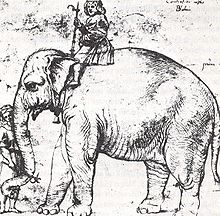This article includes a list of general references, but it lacks sufficient corresponding inline citations. (April 2024) |



The history of elephants in Europe dates back to the time of the Roman Empire, but previously, during the Ice Age, relatives of elephants were spread across the globe, including Europe. Mammoths roamed the northern parts of the Earth, from Europe to North America. The straight-tusked elephant of mainland Europe principally inhabited the Mediterranean, but reached the rest of Europe during warm interglacial periods. While it went extinct during the last Ice Age, insular dwarf forms such as the Cyprus dwarf elephant, the pygmy elephant, the Naxos dwarf elephant and the Rhodes dwarf elephant survived longer, and the last Mediterranean elephant species survived on Tilos until about 4000 years ago.[1] Subsequently the presence of actual elephants in Europe was only due to importation of these animals.